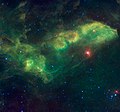File:Jabbah Nu Scorpii Aa WISE.jpg
From HandWiki

Size of this preview: 645 × 599 pixels. Other resolutions: 517 × 480 pixels | 11,300 × 10,500 pixels.
Original file (11,300 × 10,500 pixels, file size: 5.67 MB, MIME type: image/jpeg)
File history
Click on a date/time to view the file as it appeared at that time.
| Date/Time | Thumbnail | Dimensions | User | Comment | |
|---|---|---|---|---|---|
| current | 17:14, 28 January 2023 |  | 11,300 × 10,500 (5.67 MB) | imagescommonswiki>Liandrei | {{Information |Description= NASA/JPL: 'Jabbah is the name of the bright star right of center, surrounded by a red colored dust cloud. The Arabic name means "the forehead of the scorpion." This view from NASA's Wide-field Infrared Survey Explorer, or WISE, takes in an area of the sky in the constellation of Scorpius surrounding Jabbah, which is larger than a grid of eight by eight full moons. Though Jabbah appears to be a single star, it is actually a whole system of stars (possibly as many a... |
File usage
The following file is a duplicate of this file (more details):
- File:Jabbah Nu Scorpii Aa WISE.jpg from Wikimedia Commons
The following page uses this file:


